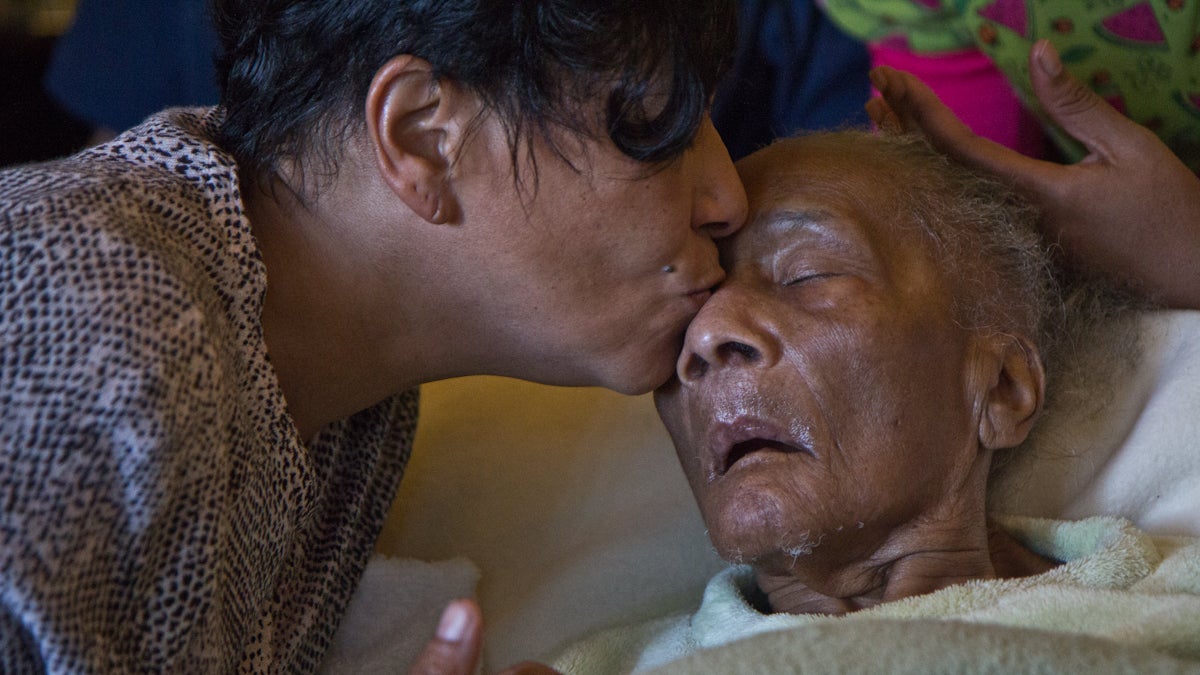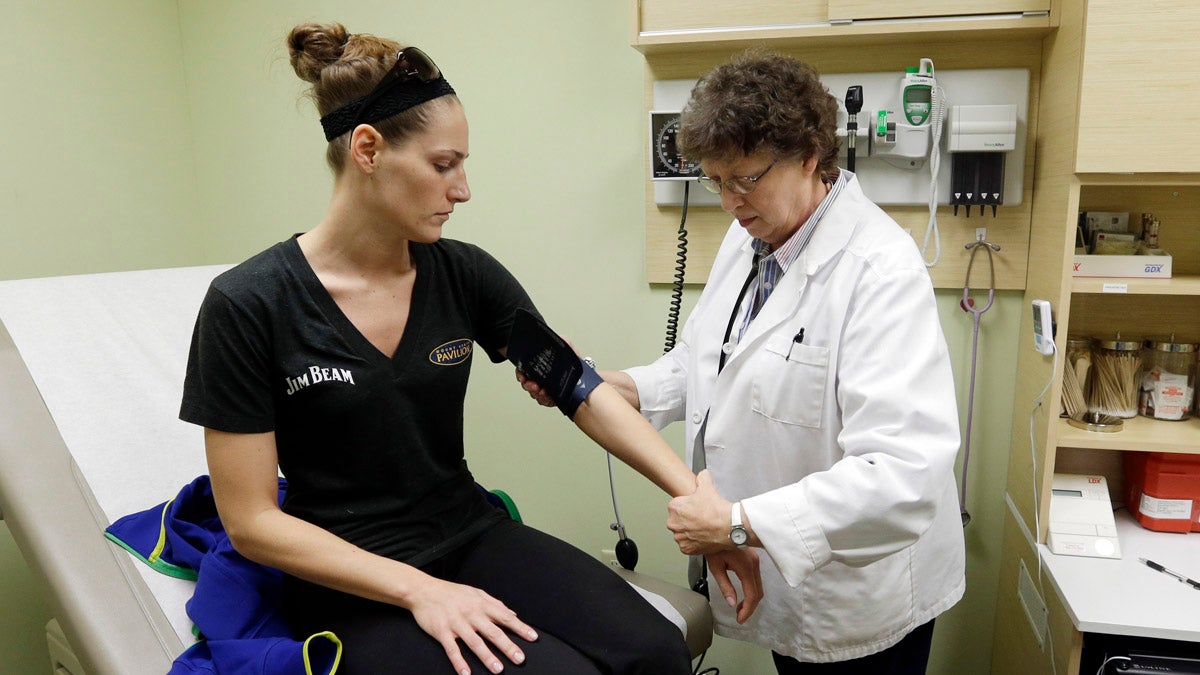How do caregivers learn skills to keep a loved one safe at home?
Listen
Angela Bobo and family members take turns caring for her mother
Dementia has been slowly stealing Ruth Perez’s memory and thinking ability for 20 years.
“She would put food together that didn’t belong together–hamburger and fish in a pot–mom never cooked like that,” said Angela Bobo, Perez’s daughter.
The mother and daughter live together in Chester, Pennsylvania, just outside of Philadelphia.
Perez is the center of the family, and spends much of her day tucked under a fleece blanket—on a barcalounger in the middle of the living room. The 86 year old doesn’t seem to notice as her daughter and grown grandchildren come and go, but they keep up a steady one-sided conversation with her anyway.
“If I kiss her, she might lean towards me, and sometimes she’ll nod,” said Bobo. “What she can do at times is: she can smile at you and say a word like, ‘uh huh.'”
Perez can’t lift her arms or move her legs.
A rotating crew of family members takes turns caring for her. They are experienced, they have routines and schedules. But a few months ago, the pressure of lying in one place created a small blister on Perez’s hip. The blister burst and that became a bedsore. Without good blood flow, the wound didn’t heal–and grew bigger and deeper. When skin and tissue in the bedsore started to die, Bobo says it was hard to ignore the smell from the open wound.
“I couldn’t get it to go away,” Bobo said. “When I say we were at our wit’s end to fix this, we were beyond there.”
“In too many cases, people just learn this stuff by themselves and that’s really kind of dangerous,” said John Schall, CEO of the Caregiver Action Network.
Especially when an illness is unexpected or a loved one suddenly needs around-the clock-care, daughters and sons, husbands and wives become caregivers.
Schall says most times, no one has taught him or her how to change a colostomy bag or how to keep a urine catheter clean.
44 million unpaid family caregivers
As Americans live longer, that silver tsunami you’ve heard about is sweeping people into a new role as a family caregiver. Schall said, often, it’s a woman in her late 40s with a full-time job—and kids, and usually she’s caring for a mother or a mother-in-law. But that image is changing. Now 40 percent of caregivers are men, and more millennials help care for someone at home, he said.
It’s an area of American life where the responsibility—and sacrifice—is becoming more equal.
About 44 million Americans are unpaid family caregivers—sometimes for a child with special needs, more often for a frail older adult – according to a 2015 estimate from the National Alliance for Caregiving.
Alliance president Gail Gibson Hunt says hospitals need to do more than plop discharge papers in a patient’s lap and wheel them out the door. Some hospitals are so eager to discharge patients, they don’t prepare caregivers for what’s ahead, she said.
“But particularly in the case of people caring for the elderly, generally speaking, if they’ve had some major episode, they are not going back to where they were before.” Gibson Hunt said. “It’s really setting up the family caregiver for disastrous expectations, so that they think: maybe I’ll take off from work for a week or something.”
“Then they get home and within that first 24 hours, think ‘gosh, we can’t handle this, we need some home health care,'” John Schall said.
But hiring help at home for just a few hours a week can cost $10,000 to $15,000 a year, he said.
Schall doesn’t know of any in-person classes that teach family caregiver nursing skills, but his group has online resources, including a Webinar on preventing medicine mishaps, and a FAQ page about caring for someone with bladder control problems.
Ken —a retired tech guy from North Carolina —became a caregiver for his wife, Genie, for just a few months 10 years ago, when the two were in their mid-50s.
“What we needed was for someone to sit me down in a class and say: ‘here’s how you change the sheets while she’s still in the bed, here’s how you take her blood pressure, here’s how you monitor her breathing,'” Ken said.
Ken worried he’d drop her as they struggled to get to the bathroom. He wasn’t sure when to call 911. That uncertainty weighed on Ken—especially when Genie was rushed back to the hospital three times.
“I let her drink too much out of the straw,” Ken said. After a silent moment struggling with his emotions, he added: “If I had been better, I might have been able to avoid having her go into the hospital.”
Less than half a year of medical care for Genie cost more than $100,000. The insurance company paid up, but Ken says the health plan didn’t call once to say: ‘How’s it going?’
“A few hours of instruction, how much can that cost?” he said.
“When patients leave the hospital, they generally leave quick and sick,” said Susan McAllister, Medical Director of Quality in the Division of Hospital Medicine at Cooper University Health Care in Camden, New Jersey. Her team includes the social workers; home health nurses and others who help plan a patient’s discharge from the hospital.
McAllister says, these days, it’s common to come in with a heart attack, get medicine to open a blocked artery—and leave just 48 hours later. McAllister says the short hospital stay isn’t a problem—but the transition home has to be done right.
The CARE Act
Since 2014, California, New Jersey, Oklahoma, New York and 17 other states passed their version of the Caregiver Advise, Record, Enable (CARE) Act.
Across the country, AARP lobbied strongly for the proposals.
The CARE Act requires hospitals and rehabilitation facilities to record the name of the caregiver in the patient’s medical chart. Medical centers and rehab centers must offer caregivers basic training or instructions, and the caregiver is supposed to be notified if a patient is discharged to another family member or back home.
John Schall from the Caregiver Action Network says, early on, state hospital associations–in some states–around the country opposed the new rules. Executives expressed concerns about more mandates and more paperwork—and they claimed their staffers were already doing the tasks required by the CARE Act.
“To their credit, they learned it was not happening nearly as often as they thought it was,” Schall said. “They really had to pivot to a position of support from a beginning opposition stance.”
McAllister says years ago, Cooper Hospital realized it needed to do a lot more to make sure people were healing safely at home. From day one, caregivers are part of discharge planning, she says. On day two, a social worker might help the family shop for help at home.
“On day three, we may start teaching inside the hospital,” McAllister said.
Hospitals don’t get paid more for those extra steps. But Medicare “dings” medical centers with a financial penalty if too many patients bounce back to the hospital and have to be re-admitted. The federal government’s Hospital Readmissions Reduction Program was created under the Affordable Care Act.
“Here in Maine, we have found that regulations like Medicare’s penalty for readmissions within 30 days, and expansion of Accountable Care Organizations have really been the driving force in enhancing our hospitals’ discharge procedures, rather than the relatively new CARE Act,” according to a written statement from the Maine Hospital Association.
Lessons at home
For the caregivers at home, many feel the responsibility lies on them.
“It scares you,” said Angela Bobo, in reference to her mother, Ruth. “When I’m in pain, I can tell you. She can’t tell me that’s she’s in pain, that’s when I said: ‘I’m going to take her to the doctor’s, because I don’t know what’s going on with this.'”

Angela Bobo holds the hand of her mother, Ruth Perez. Bobo is Perez’ at-home caregiver. (Kimberly Paynter/WHYY)
The physician basically wrote a prescription saying her mom needed more help. That way, Medicare pays for skilled nursing care at home and Angela Bobo got lessons in cleaning and dressing her mother’s wound. Now she knows what signs to look for.
“I told her it’s going to get worse before it gets better,” said David Wilson, a registered nurse from Crozer-Keystone Home Health and Hospice. He’s a wound-care specialist whose job is house calls.
“To get a wound better, you have to remove the dead tissue and start from the ground up,” Wilson said.
Some nurses come to the house, do their job and leave, but Wilson says teaching is part of his work. Lots of times he’s the one nudging reluctant family caregivers who worry they’re going to do the wrong thing.
“I will tell you in home care, the biggest thing is fear,” Wilson said.
At Angela Bobo’s house, Wilson recommended a new wound-care regimen for Ruth Perez’ bedsore, and Perez got an airflow mattress that relieves the pressure on her skin. Medicare pays for that, too.
The home health nurse also checks for safety guardrails at the house, and looks around for tripping hazards. But most reassuring of all—for a few weeks, nurse David Wilson will keep coming back.
WHYY is your source for fact-based, in-depth journalism and information. As a nonprofit organization, we rely on financial support from readers like you. Please give today.



